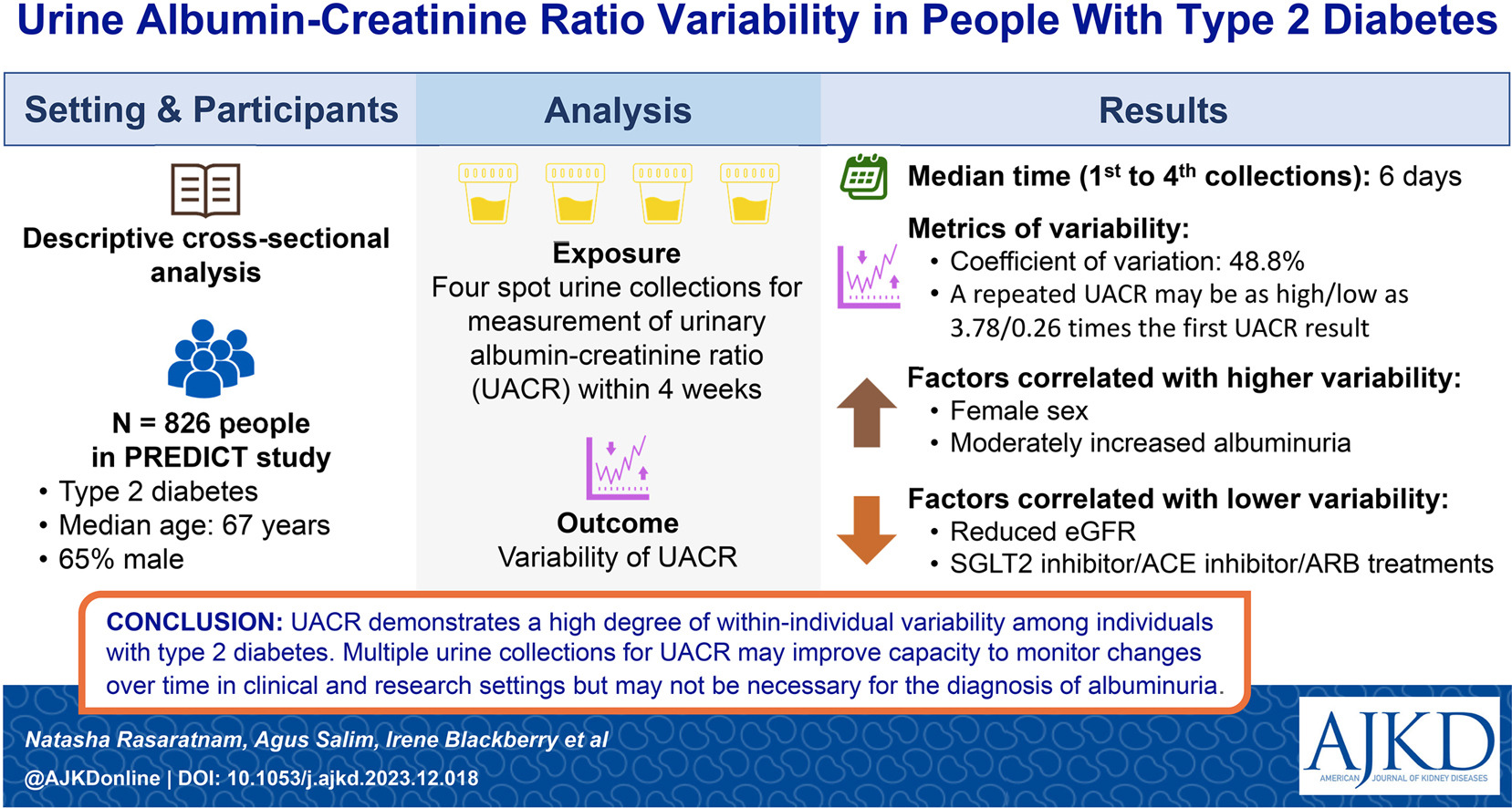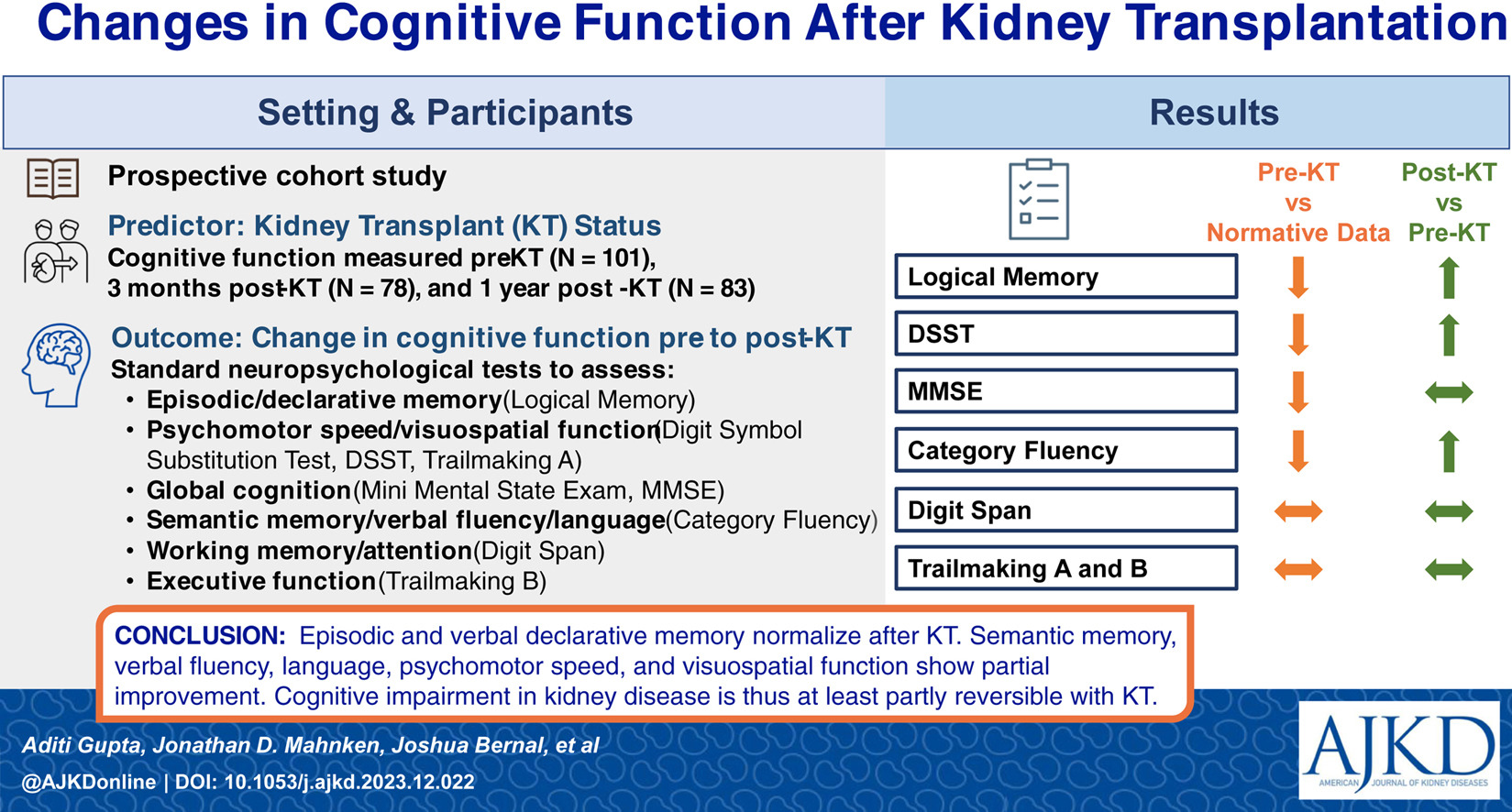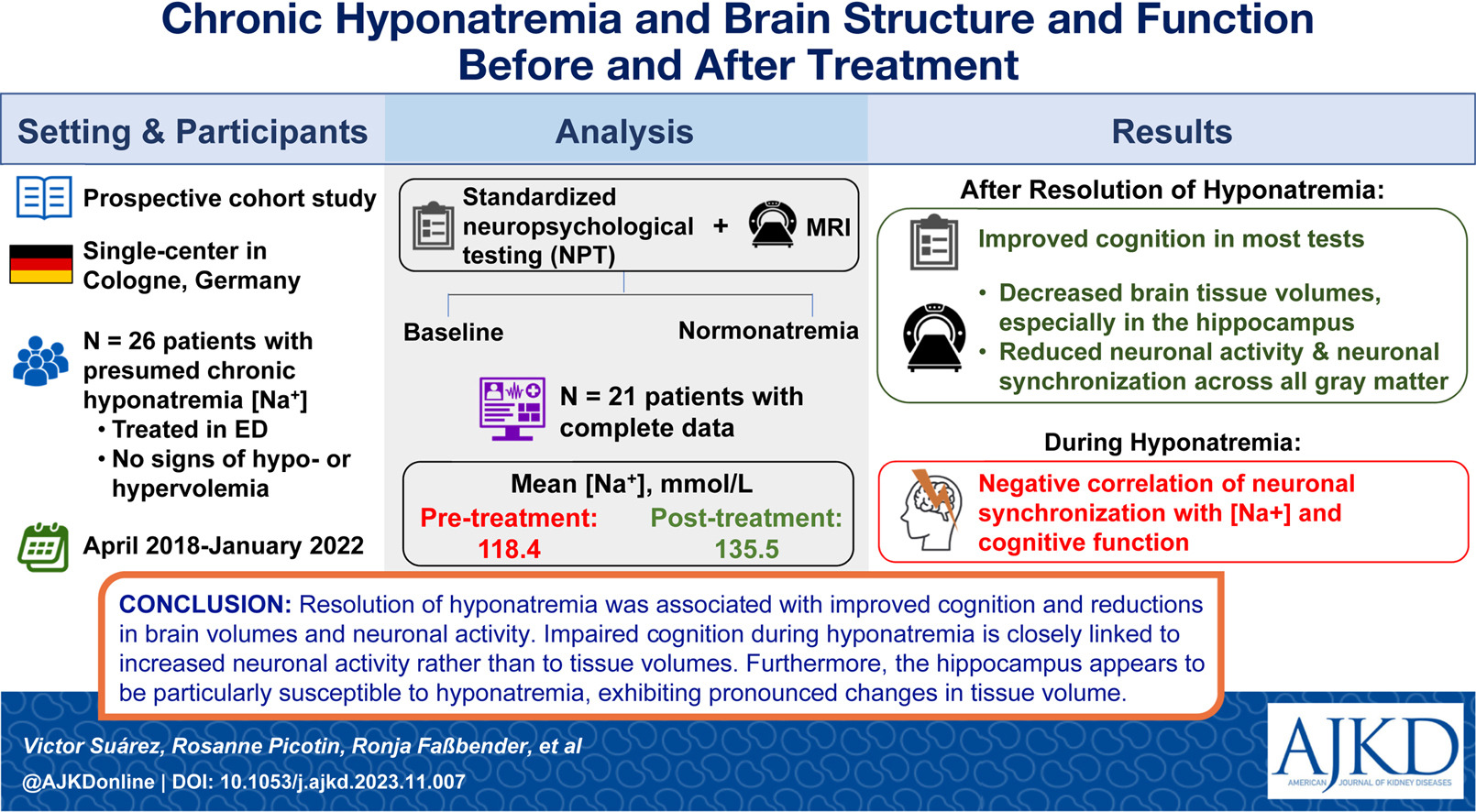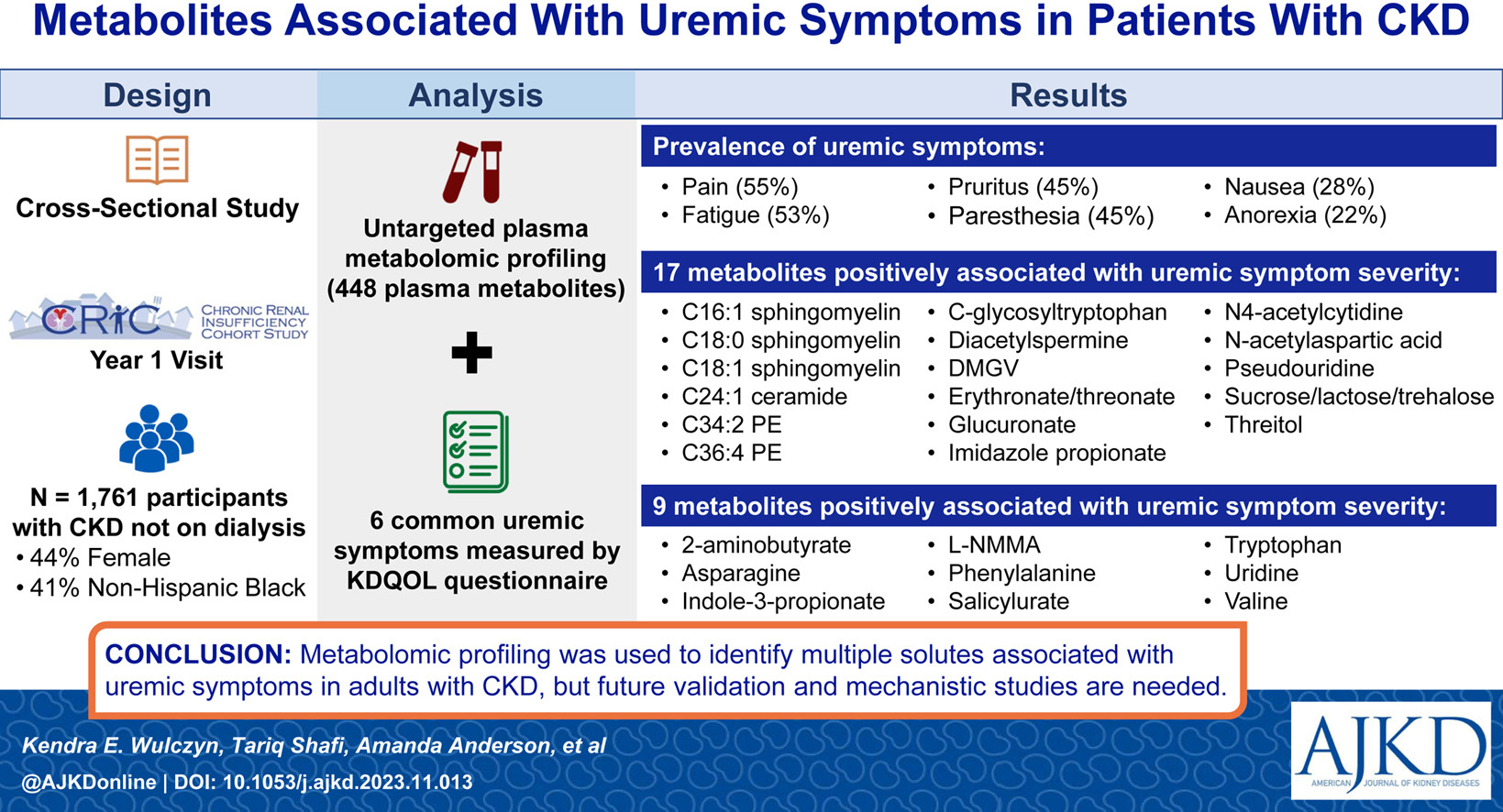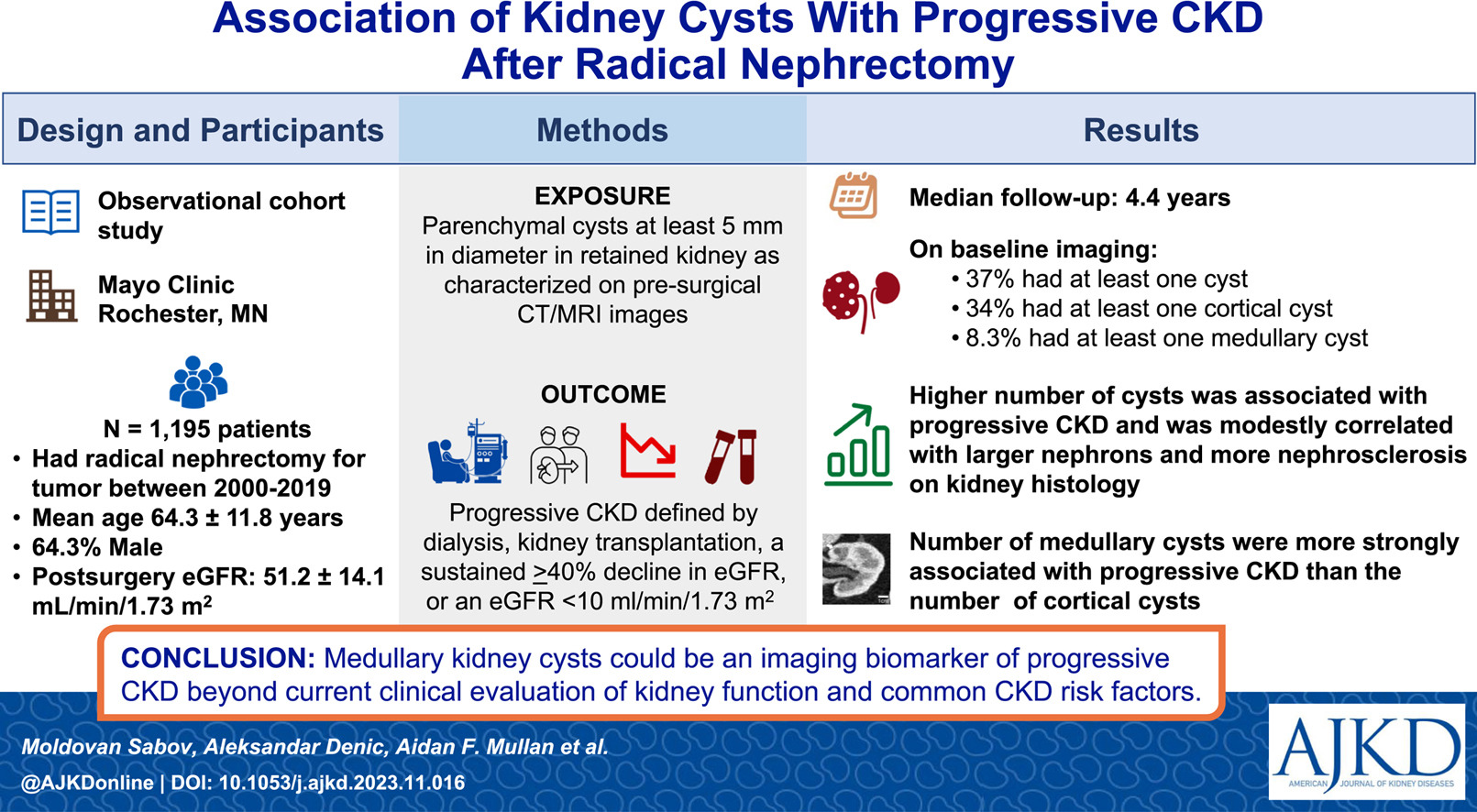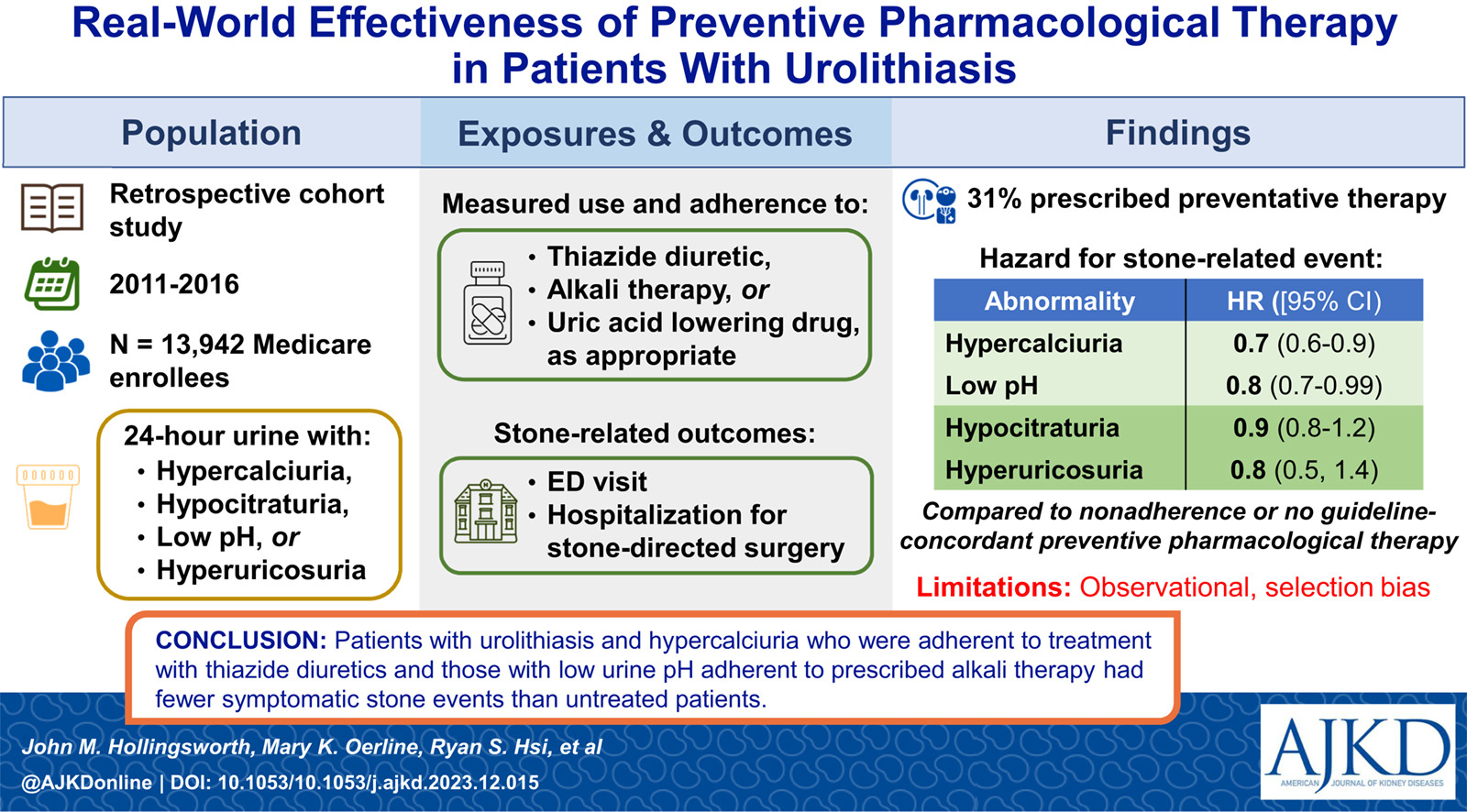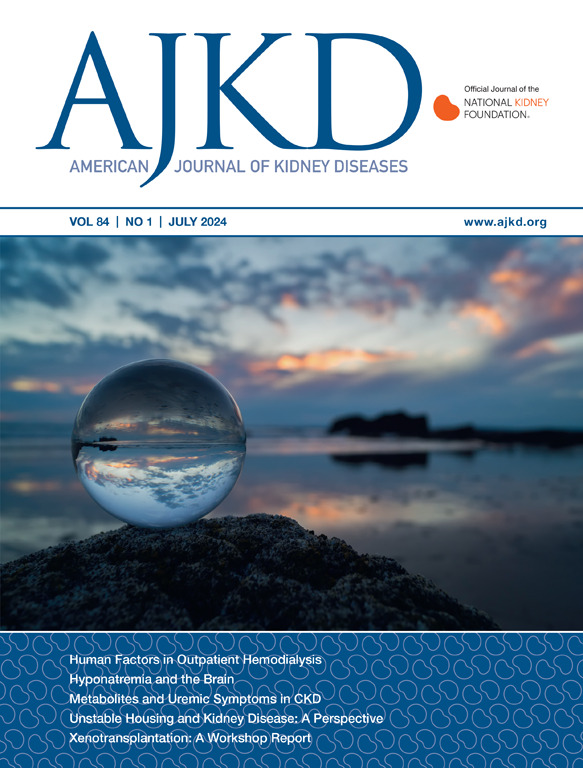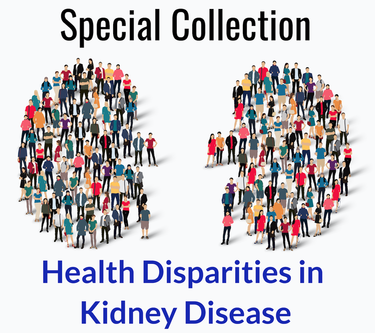Editor’s Note: We asked authors of Original Investigations to provide short plain-language summaries that would briefly summarize what inspired their study, the basic approach taken, what was learned, and why it matters. We hope our readers will find this valuable in helping them keep up with the latest research in the field of nephrology.
Highlights from the July 2024 issue:
Urine Albumin-Creatinine Ratio Variability in People With Type 2 Diabetes: Clinical and Research Implications by Natasha Rasaratnam et al
From the authors: Albuminuria (albumin in urine) is a diagnostic and prognostic marker of diabetic chronic kidney disease. However, albuminuria can vary within an individual from day to day. We compared 4 random spot urinary albumin-creatinine ratio (UACR) samples from 826 participants. We found that a second UACR collection may be as small as a fourth or as large as almost 4 times the first sample’s UACR level. This high degree of variability presents a challenge to our ability to interpret changes in albuminuria. Multiple collections have been suggested as a solution. We have constructed tools that may aid clinicians in deciding how many urine collections are required to monitor and diagnose albuminuria. Multiple urine collections may be required for individual monitoring but not necessarily for diagnosis.
DOI: 10.1053/j.ajkd.2023.12.018
Changes in Cognitive Function After Kidney Transplantation: A Longitudinal Cohort Study by Aditi Gupta et al [OPEN ACCESS]
From the authors: Cognitive impairment in kidney disease affects self-esteem, vocational abilities, quality of life, health care costs, and mortality. It is not clear whether kidney transplantation (KT) improves cognition and whether the improvement is uniform across cognitive domains. The distinction between reversible and irreversible cognitive impairment has important implications in the clinical care of patients before and after KT. We assessed cognition before KT and 3 months and 12 months after KT and discovered that episodic and verbal declarative memory normalized with KT. Semantic memory, verbal fluency, language, psychomotor speed, and visuospatial function also improved with KT but did not reach normal levels. Cognitive impairment in kidney disease is therefore at least partly reversible.
DOI: 10.1053/j.ajkd.2023.12.022
EDITORIAL: The Impact of Kidney Transplantation on a Breadth of Cognitive Measures by Nidhi Ghildayal et al [FREE]
Chronic Hyponatremia and Brain Structure and Function Before and After Treatment by Victor Suárez et al [OPEN ACCESS]
From the authors: Hyponatremia is a common clinical problem, and patients often present with neurologic symptoms that are at least partially reversible. This study used neuropsychological testing and magnetic resonance imaging to examine patients during and after correction of hyponatremia. Treatment led to an improvement in patients’ cognition as well as a decrease in their brain volumes, spontaneous neuronal activity, and synchronized neuronal activity between remote brain regions. Volume effects were particularly prominent in the hippocampus, an area of the brain that is important for the modulation of memory. During hyponatremia, patients with the lowest sodium concentrations had the highest levels of synchronized neuronal activity and the poorest cognitive test results.
DOI: 10.1053/j.ajkd.2023.11.007
Metabolites Associated With Uremic Symptoms in Patients With CKD: Findings From the Chronic Renal Insufficiency Cohort (CRIC) Study by Kendra E. Wulczyn et al
From the authors: Individuals living with chronic kidney disease (CKD) often experience symptoms related to CKD, traditionally called uremic symptoms. It is likely that CKD results in alterations in the levels of numerous circulating substances that, in turn, cause uremic symptoms; however, the identity of these solutes is not known. In this study, we used metabolomic profiling in patients with CKD to gain insights into the pathophysiology of uremic symptoms. We identified 26 metabolites whose levels were significantly associated with at least one of the symptoms of fatigue, anorexia, itchiness, nausea, paresthesia, and pain. The results of this study lay the groundwork for future research into the biological causes of symptoms in patients with CKD.
DOI: 10.1053/j.ajkd.2023.11.013
Association of Kidney Cysts With Progressive CKD After Radical Nephrectomy by Moldovan Sabov et al
From the authors: Kidney cysts are common and often are considered of limited clinical relevance despite being associated with lower glomerular filtration rate. We studied a large cohort of patients who had a kidney removed due to a tumor to determine whether cysts in the retained kidney were associated with kidney health in the future. We found that more cysts in the kidney and, in particular, cysts in the deepest tissue of the kidney (the medulla) were associated with progressive kidney disease, including kidney failure where dialysis or a kidney transplantation is needed. Patients with cysts in the kidney medulla may benefit from closer monitoring.
DOI: 10.1053/j.ajkd.2023.11.016
Designing an Implementable Clinical Prediction Model for Near-Term Mortality and Long-Term Survival in Patients on Maintenance Hemodialysis by Benjamin A. Goldstein et al
From the authors: Clinical prediction models (CPMs) are not widely used for patients undergoing maintenance hemodialysis (MHD). Although a variety of CPMs have been reported in the literature, many of these were not well-designed to be easily implementable. We consider the performance of an implementable CPM for both near-term mortality and long-term survival for patients undergoing MHD. Both near-term and long-term models have similar predictive performance, but the long-term models have greater clinical utility. We further consider how the differential performance of predicting over different time horizons may be used to impact clinical decision-making. Although predictive modeling is not regularly used for MHD patients, such tools may help promote individualized care planning and foster shared decision-making.
DOI: 10.1053/j.ajkd.2023.12.013
Real-World Effectiveness of Preventive Pharmacological Therapy in Patients With Urolithiasis: A Retrospective Cohort Study by John M. Hollingsworth et al
From the authors: Despite multiple clinical trials demonstrating the efficacy of thiazide diuretics and alkali for secondary prevention of kidney stones, they are infrequently prescribed due in part to a lack of data about their effectiveness in real-world settings. We analyzed medical claims from older adults with kidney stones for whom urine chemistry data were available. We found that patients who took prescribed thiazide diuretics for elevated urine calcium levels or alkali for low urinary pH were less likely to experience symptomatic stone recurrences than untreated patients. This benefit was expressed as lower rates of emergency department visits after initiating therapy. Our findings should inform the prescription of and adherence to treatment with thiazide diuretics and alkali for the prevention of recurrent kidney stones.
DOI: 10.1053/j.ajkd.2023.12.015
Perspective in the July 2024 issue:
Addressing Housing Issues Among People With Kidney Disease: Importance, Challenges, and Recommendations by Tessa K. Novick and Ben King
Kidney disease disproportionately impacts people with low socioeconomic status, and low socioeconomic status is associated with worse outcomes for people with kidney disease. Unstable housing, which includes housing insecurity and homelessness, is increasing due to rising housing costs. There is mounting evidence that unstable housing and other health-related social needs are partially driving worse outcomes for people with low socioeconomic status. In this perspective, the authors consider the challenges to addressing housing for people with kidney disease, such as difficulty with identification of those with unstable housing, strict eligibility criteria for housing support, inadequate supply of affordable housing, and flaws in communities’ prioritization of affordable housing. The authors discuss ways to tailor management for people experiencing unstable housing with kidney disease, and the importance of addressing safety, trauma, and emotional concerns as a part of care. They identify opportunities for the nephrology community to surmount challenges through increased screening, investment in workforce dedicated to community resource navigation, advocacy for investment in affordable housing, restructuring of communities’ prioritization of affordable housing, and conducting needed research. Identifying and addressing housing needs among people with kidney disease is critical to eliminating kidney health disparities.
DOI: 10.1053/j.ajkd.2024.01.521
Like a crystal ball, predictive analytics holds the potential to see into the future to personalize and improve dialysis care. Accurate prediction models that forecast clinical outcomes over different time horizons may profoundly impact clinical decision-making. In this issue of AJKD, Goldstein et al report models for near-term mortality and long-term survival using easily accessible clinical data on patients undergoing maintenance hemodialysis. The application of these models to guide clinical decision-making needs to be tested prospectively.
The image “Portal” by Phil Dolby is released on Flickr under the CC BY 2.0 deed license. Special thanks to Editorial Intern George Vasquez Rios for curating the cover image and drafting the cover blurb for this issue.
SPECIAL COLLECTION: HEALTH DISPARITIES
The articles in this special collection highlight various types of disparities that impact patients with kidney diseases.
- The Renal Warrior Project. Join Now
- Source: https://ajkdblog.org/2024/07/01/highlights-from-the-july-2024-issue/

